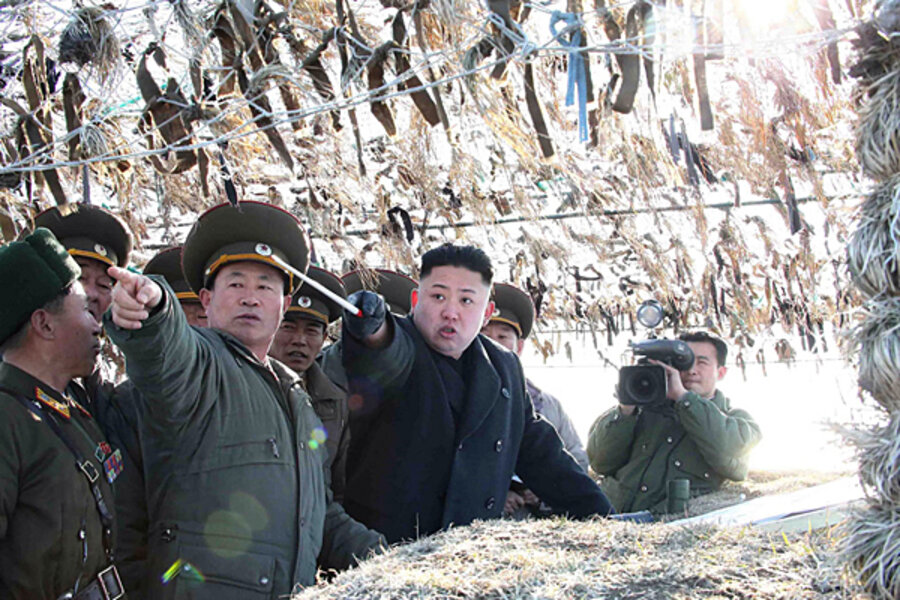North Korea threat: How one island is taking Kim Jong-un more seriously
Loading...
| Baengnyeong Island, South Korea
For six decades, the residents of South Korea’s Baengnyeong Island have practically stared down the barrels of North Korea’s artillery. Located just 10 miles off the North’s Yellow Sea coast, this South Korean island is at the forefront of what some observers say could be the next military flashpoint.
Now, amid the recent uptick in bombast from Pyongyang, the regime has singled out the island for a possible attack. And, even as much of the rest of South Korea seems to remain unfazed by the North’s rhetoric, South Koreans here are taking the recent threats seriously, if calmly.
“North Korea’s recent aggression, the fact that it does not recognize the maritime border in those waters, and South Korea’s pledge to respond to any provocation with force increases the likelihood of an incident in this area,” says Yang Moo-jin, a North Korea analyst at Seoul’s Dongguk University.
If the North made good on its promise, it would be the latest in a series of battles around South Korea’s five Yellow Sea islands. Even during times of relative calm on the Korean peninsula, the navies of both nations have engaged in deadly skirmishes. In 2010, a South Korean naval ship sank not far off Baengnyeong’s shore: The South later determined it was struck by a North Korean torpedo, resulting in the deaths of 46 sailors. And later that year, Yeongpyeong Island was shelled by the North’s military, killing four South Korean soldiers and civilians.
That incident hit close to home for many of Baengnyeong’s 5,500 residents. Since then, new fortifications on the island have been built, and South Korea’s military has bolstered its presence there. Officials on the island estimate that troop numbers now hover around 4,000, but the actual total is a military secret.
The island is prepared, says Kim Jin-guk, who heads Baengnyeong’s Civil Defense Force.
“Many of the locals say they feel safe because we have close to 90 bomb shelters on the island and we have a large number of soldiers and marines stationed here," Mr. Kim says. “This might make Baengnyeong Island more safe than some other parts of the mainland.”
Last month, Pyongyang’s official Korea Central News Agency reported that North Korea's leader Kim Jong-un ordered troops on a military base just across the sea from Baengnyeong to take aim at the island if war breaks out with the South and "engulf the island with flames." The Civil Defense Force’s Kim says despite that directive, residents remain calm and, to his knowledge, no one has fled the island.
“I trust that the military would protect us,” says Park Dong-sik, the owner of a hotel on Baengnyeong Island. “The situation is very tense, but I would never leave the island because of North Korea’s threats.”
While Pyongyang escalates the belligerence of its daily diatribes directed at Seoul and Washington, most South Koreans remain unmoved by the rhetoric. Some observers say this apathy is a coping mechanism.
“It’s a part of their psyche,” says analyst Jasper Kim. “You either ignore the noise from North Korea, or you simply go crazy.”
Mr. Kim, who heads the Asia-Pacific Global Research group in Seoul, says that Koreans have always lived in range of the North’s guns, but have had little choice but to accept the reality of the situation no matter how grave it might seem.
“It’s like living next to a nuclear power plant, you know that there is a small likelihood that something could go terribly wrong, but you don’t want to question it on a daily basis, because then you start questioning why you are there in the first place,” Kim says.
Still, the barrage of threats might be taking its toll on Baengnyeong’s residents, where tourism, the island's main source of income, is down. For some, like Lee Hwan-sun, the heightened tensions in the Yellow Sea means he cannot earn a living.
“I used to take my fishing boat out about five minutes from the port,” he says. “But now, because of the situation here, I wouldn’t dare go out that far.”
“We’re scared of Kim Jong-un, he’s unpredictable, he’s worse than his father,” says one local woman in her 70s, who did not want to give her name.
Though most South Koreans are not panicking, there are signs that they are growing tired of the North’s rhetoric. Since the 2010 incidents, the South Korean government has faced criticism for not reacting more strongly to such incidents. That has prompted new President Park Geun-hye to give the Ministry of Defense carte blanche in the event of another North Korean military provocation. This in turn increases the probability of the current war of words turning into a firefight, says analyst Kim.
“They [the South Korean government] have created a broad definition of what a provocation is from North Korea,” Kim says. “Something very small could demand a military countermeasure by the other side and that’s where problems can arise.”







